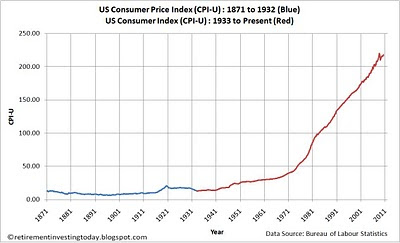To try and squeeze some more performance out of a retirement investing strategy that is heavily focused on asset allocation I am using a cyclically adjusted PE ratio (known as the PE10 or CAPE) for the ASX 200 to attempt to value the Australian Stock Market. The method used is based on that developed by Yale Professor Robert Shiller for the S&P 500. I will call it the ASX 200 PE10 and it is the ratio of Real (ie after inflation) Monthly Prices and the 10 Year Real (ie after inflation) Average Earnings. For my Australian Equities I will use a nominal ASX 200 PE10 value of 16 to equate to when I hold 21% Australian Equities. On a linear scale I will target 30% less stocks when the ASX 200 PE10 = 26 and will own 30% more stocks when the ASX 200 PE10 = 6.
Saturday 22 May 2010
Thursday 20 May 2010
US Consumer Price Index (CPI) Inflation – April 2010 Update
The above chart shows the US Consumer Price Index (CPI-U) to April 2010 courtesy of the US Bureau of Labor Statistics. Year on year the US CPI inflation index has risen from 213.24 to 218.009 which equates to 2.2% today (down from 2.3% last month). Annualising the last 6 months has inflation at 1.7% and annualising the last 3 months has inflation running at 2.4%.
Wednesday 19 May 2010
UK Inflation – May 2010 Update
The Office for National Statistics has reported the April 2010 UK Consumer Price Index (CPI) as 3.7% up from 3.4% and the UK Retail Price Index (RPI) as 5.3% which is up from 4.4% last month. Regular readers of Retirement Investing Today will I’m sure not be surprised by this at all as the Bank of England have clearly positioned themselves to let inflation run.
Tuesday 18 May 2010
A History of Severe Real S&P 500 Stock Bear Markets – May 2010 Update
Looking at the first chart which shows the real (inflation adjusted) S&P 500 (or its predecessor) stock market I have identified three historic severe stock bear markets. These I am defining as stock markets where from the stock market reaching a new high, they then proceeded to lose in excess of 60% of their real (inflation adjusted) value. These are best demonstrated by the second chart which shows each of these stock bear markets and the fall in percentage terms from the peak. So briefly what were these bear markets (full details here).
Monday 17 May 2010
US (S&P 500) stock market including the cyclically adjusted price earnings ratio (PE10 or CAPE) – May 2010 Update
To try and squeeze some more performance out of a retirement investing strategy that is heavily focused on buy & hold and asset allocation I am using a Cyclically Adjusted Price / Average 10 Year Earnings (PE10 or CAPE) ratio for the S&P 500 to value the US (specifically the S&P 500) stock market. The method used is that developed by Yale Professor Robert Shiller however I also incorporate earnings estimates up to the PE10 month of interest. Background information here.
Subscribe to:
Posts (Atom)














